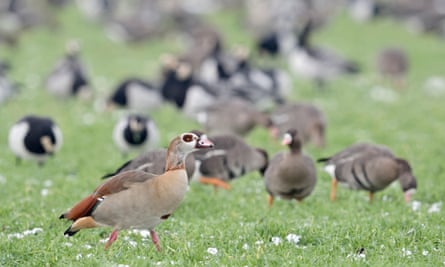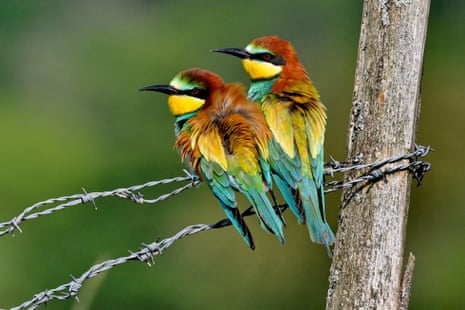Europe’s breeding bird populations have shifted on average one kilometre north every year for the past three decades, likely driven by the climate crisis, according to one of the world’s largest citizen science projects on biodiversity.
The European Breeding Bird Atlas (Ebba2) provides the most detailed picture yet of the distribution of the continent’s birds after 120,000 volunteers and fieldworkers surveyed 11m square kilometres, from the Azores in the west to the Russian Urals in the east.
The book documents changes in the range of Europe’s 539 native bird species in the 30 years since the first Ebba, which was published in 1997 but was based on observations from the 1980s. It shows that since the first study, each population can be found around 28km further north.
Quick GuideThe fastest-shifting species
Show
The birds whose breeding ranges have moved furthest over the past 30 years
Pallid harrier Circus macrourus 1,060 miles (1,707 km)
Marsh sandpiper Tringa stagnatilis 476 miles (766 km)
Peregrine Falco peregrinus 429 miles (691 km)
Baillon's crake Zapornia pusilla 333 miles (536 km)
Ruddy shelduck Tadorna ferruginea 286 miles (461 km)
Mediterranean species such as the European bee-eater and little egret are now reaching the UK, France and the Netherlands, mainly due to milder winters. Eurasian bittern, pied avocet and red kites have also expanded their range, probably in response to better protection of habitats coupled with laws banning persecution.
Overall, 35% of birds increased their breeding range, 25% contracted their breeding range and the rest did not show any change, or the trend is unknown. Forest birds and those protected by international legislation have generally expanded their range, while farmland birds occupy a smaller total area.
Generally, if a species is present in more areas it is less likely to go extinct, but it could be spreading out because of habitat deterioration, and not because the population has increased. “The results are confirmation that the major driving forces are climate change and land-use change. At the same time, the situation is really very complex, and that’s why we will provide this dataset for further exploration and investigation,” said Dr Petr Voříšek from the Czech Society for Ornithology.
Quick GuideWhat is citizen science?
Show
Citizen science is research performed by non-scientists, usually members of the public. It has led to numerous discoveries, from new planets and animal species to insights on coral reef restoration and butterfly populations. Nasa, the Natural History Museum and even the US government are among the many organisations that ask members of the public, including children, to help collect data, interpret results and solve research problems for scientific projects.
Can citizen science help biodiversity?
Citizen science plays a vital role in monitoring plant and animal populations around the world, often through mobile phone applications. iNaturalist, a joint initiative between the California Academy of Sciences and the National Geographic Society, allows users to photograph and identify plant species around the world, informing scientific research. Nearly 35m observations of 269,859 species have been uploaded to the platform in towns, cities and rural areas from every continent.
Is it useful even in a pandemic?
Yes. Whether you are documenting the organisms you see during your daily hour of exercise or just recording what you see from your window, the biodiversity you document will further scientific research. While stuck at home, you could even help scientists count penguins in Antarctica, monitor global seal populations or record large mammal sightings in Gabon.
Useful projects and applications
Zooniverse lists several projects you can help with that are not just limited to biodiversity.
The Wildlife Trusts is asking for volunteers on citizen science projects.
iNaturalist, eBird and Tree ID are among the hundreds of citizen science phone applications for biodiversity available.
Dr Iván Ramírez, senior head of conservation at BirdLife Europe and central Asia, said: “Those birds that have been legally protected have been doing better than those which are not protected. This is a really important message within the European Union. We have one of the oldest policies – the Birds Directive – and we can prove that it works.” Birds protected by the Bern Convention, such as white-tailed eagles, are also doing better.
As the climate warms, forests are stretching into boreal and Arctic regions. In parts of northern Europe there has also been tree planting (mainly for wood and paper) and land abandonment (specifically in Mediterranean areas) which have damaged farmland birds but benefited many woodland species such as woodpeckers and warblers.
Alpine species are also losing out as scrubby trees and vegetation colonise higher mountain slopes, shrinking the range of mountain grassland specialists such as wallcreepers and water pipits.
Generally, farmland birds are big losers, suffering overall declines in population and reduced distribution because agricultural intensification means there is less food, such as insects and residue from harvesting. The State of Nature in the EU 2013-2018 assessment showed 80% of key habitats were in poor or bad condition, and intensive farming is a major driver of decline. The UK’s farmland birds have declined by 55% since 1970.

If birds are forced into new habitats on the edge of their range this can also put them under stress, particularly migratory species such as swifts and swallows, where small changes in timings have considerable implications. “Birds are optimised machines,” said Ramírez. “They have been learning for generations and millennia how to do these migrations. They have genetically been designed to do a migration of x kilometres. If you’re putting x plus 10 or 15 kilometres, you are putting them under stress.”
The data also showed an increase in non-native species. One in 10 breeding bird species is non-native (57 in total), and 39 of these arrived in the past 30 years, including the ring-necked parakeet, monk parakeet and Egyptian goose, which are all likely to be expanding their territories.
Ramírez said this is caused by the “perfect storm” – an increase in the wildlife trade, climate change making European habitats more suitable for exotic birds and an abundance of food in urban areas. Invasive species is one of the top five drivers of biodiversity decline globally, but researchers did not look at whether these particular species were negatively impacting native populations.
There has only been one known bird extinction in Europe in the past 30 years – the common button quail – but if trends continue there are likely to be many more in the next 30 years, said Ramírez. Populations will decline in sub-optimal habitats until they reach a limit beyond which they collapse. “What the science tells me, and what I’ve seen after 20 years working on birds, is that every single time we publish a new report, the overall state of birds is always declining. This hasn’t changed since the 70s when the Birds Directive started, and nothing makes me believe that this is going to change,” he said.

The book is being released by the European Bird Census Council (EBCC), and has been put together by a network of partners in 48 countries using data collected between 2013 and 2017. “This is by far the widest and best coverage of all species of birds that we have in our region … international cooperation has enabled us to survey every single square in the region to a very fine detail,” said Ramírez.
To create the data, Europe was carved up into squares measuring 50 x 50km. Bird enthusiasts (mainly volunteers) from around the world recorded what birds were breeding within that space.

Ornithologists will now be able to use this data to work out why these population changes are occurring, which should in turn form the bedrock of policy. “This atlas shows, in unprecedented detail, how bird populations are changing across Europe,” said RSPB’s principal conservation scientist, Mark Eaton.
“Predictably, there are winners and losers. We can see how some species such as black-winged stilts and cattle egrets have expanded across the continent rapidly and have begun to colonise UK wetlands. In contrast, we can see ranges shrinking as species of northern Europe feel the impact of climate change, and species such as the dotterel are dwindling in numbers and range in northern Britain,” he said.
Find more age of extinction coverage here, and follow biodiversity reporters Phoebe Weston and Patrick Greenfield on Twitter for all the latest news and features
